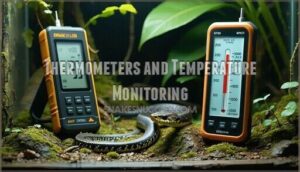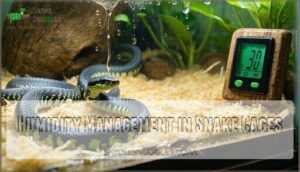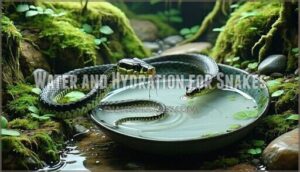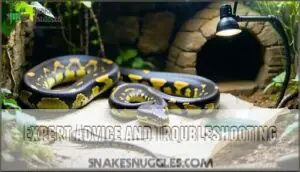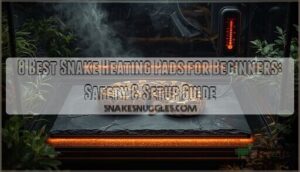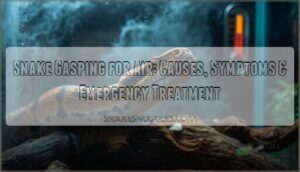This site is supported by our readers. We may earn a commission, at no cost to you, if you purchase through links.
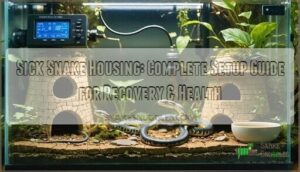
You’ll need to create a temperature gradient with the warm side running 5-10 degrees higher than their normal preferred body temperature – think of it as cranking up the heat like you would when you’re fighting a cold.
Your sick buddy will practically live on that hot spot, so make sure it’s rock-solid reliable.
Keep humidity levels steady, provide fresh water, and add extra hiding spots for security.
A stress-free environment works wonders – just like how you want peace and quiet when you’re feeling rough.
The right setup can mean the difference between a quick recovery and prolonged illness.
Table Of Contents
- Key Takeaways
- Snake Cage Essentials
- Heating and Temperature Control
- Lighting Requirements for Snakes
- Humidity Management in Snake Cages
- Water and Hydration for Snakes
- Visual Security and Hiding Places
- Branches and Climbing Structures
- Snake Health and Hygiene
- Snake Behavior and Enrichment
- Expert Advice and Troubleshooting
- Frequently Asked Questions (FAQs)
- Do you have to keep a snake in an enclosure?
- How do I create a safe home for my scaly snake?
- How do you care for a snake enclosure?
- How long should a snake enclosure be?
- What is snake Haus?
- How do I keep snakes out of my house?
- How to tell if a snake is suffering?
- What is a good cage for a snake temporarily?
- What does an unhealthy snake look like?
- How to tell if a snake has an infection?
- Conclusion
Key Takeaways
- Elevate your snake’s temperature by 5-10 degrees above normal on the warm side – sick snakes need extra heat to boost their immune system and speed recovery
- Create a stress-free environment with multiple hiding spots, steady humidity levels, and minimal handling – your snake needs peace and security to heal properly
- Use simple, clean substrates like paper towels or newspaper instead of complex bedding – you’ll easily monitor waste and prevent bacterial growth during illness
- Monitor temperature and humidity precisely with digital thermometers and hygrometers – sick snakes cannot regulate their body temperature effectively, so consistency is critical
Snake Cage Essentials
Setting up the right cage for your sick snake isn’t just about recovery—it’s about creating a healing environment that supports their natural needs.
You’ll need to focus on three key areas: proper cage size and materials, safe bedding options, and essential accessories that promote comfort without stressing your recovering pet.
Cage Size and Material
When setting up sick snake housing, you’ll need the right enclosure dimensions and material durability to support recovery.
Your cage should be at least twice your snake’s length and escape-proof with secure locks.
Consider these essential factors:
- Enclosure size: Minimum twice snake length, allowing full extension for natural movement
- Material durability: Choose glass, plexiglass, or untreated wood for easy cleaning and disinfection
- Ventilation needs: Proper airflow prevents respiratory issues during snake illness recovery
Cost analysis shows larger enclosures reduce health problems long-term.
Bedding and Substrate Options
Choose paper towels or newspaper for sick snakes—these budget-friendly options let you monitor waste and prevent ingestible risks.
Natural options like cypress mulch work for healthy snakes, but avoid cedar substrates due to substrate toxicity.
Bioactive substrates sound fancy, but simplicity wins during recovery.
A key factor is meeting species-specific needs when selecting a substrate.
Safe substrate means daily cleaning frequency and zero chance your snake mistakes bedding for breakfast!
Cage Accessories and Decorations
Once your Bioactive Substrates are in place, it’s time to deck out the enclosure with snake cage accessories.
Every snake needs a few hiding places, some Naturalistic Decor, and a dash of Climbing Enrichment. These touches help your pet feel at home and reduce stress.
Don’t forget:
- Snake hides for Hiding Variety and comfort
- Arboreal decor and branches for climbing
- Sensory stimulation with rocks, logs, or Water Features for enrichment
Your snake will thank you for providing a complete and Naturalistic environment.
Heating and Temperature Control
Temperature control becomes critical when your snake’s immune system is compromised and fighting illness.
A compromised immune system demands precision in every degree of your snake’s environment.
You’ll need to maintain precise thermal gradients that support healing while preventing additional stress from temperature fluctuations.
Heat Sources and Temperature Gradients
After setting up your enclosure’s foundation, you’ll need proper heating to support your sick snake’s recovery.
Heat tape under one-third of the enclosure floor provides consistent belly warmth, while radiant heat panels offer gentle overhead heating.
Create a temperature gradient spanning 24-32°C with hotspot placement at the warm end.
Night drops of 2-3°C help mimic natural cycles.
For consistent and safe heating, consider reptile heat tape designed for enclosures.
Temperature monitoring with digital thermometers at both ends confirms your snake can thermoregulate effectively during healing.
| Heat Source | Best Use | Recovery Benefit |
|---|---|---|
| Heat tape | Belly warmth | Aids digestion |
| Radiant panels | Ambient heating | Reduces stress |
| Ceramic emitters | Night heating | Supports immunity |
| Heat lamps | Basking spots | Boosts appetite |
Thermometers and Temperature Monitoring
Digital thermometers beat guesswork every time! Place probe sensors at both cage ends to track your temperature gradient accurately.
Calibration methods keep readings trustworthy – check against known standards monthly.
Temperature alarms alert you to dangerous swings before your snake suffers.
Infrared readings offer quick spot-checks, while probe placement guarantees continuous monitoring where your snake actually lives.
Ideal Temperature Ranges for Snakes
Temperature control becomes your snake’s lifeline during recovery.
You’ll need to establish an ideal gradient that supports healing while preventing stress.
- Cooler end: Maintain 70-75°F (21-24°C) for comfortable rest and digestion
- Basking spot: Keep 90-95°F (32-38°C) for thermoregulation and immune function
- Night temperatures: Drop to 65-70°F (18-21°C) for natural circadian rhythms
Temperature monitoring becomes critical during illness since sick snakes can’t regulate effectively.
Using a thermostat is key to precise temperature control.
Make seasonal adjustments gradually to avoid shocking their system.
Lighting Requirements for Snakes
While many people think snakes don’t need special lighting, proper illumination plays a vital role in your sick snake’s recovery and overall health.
You’ll want to understand how UV-B light, natural lighting cycles, and quality bulbs work together to create an environment that supports healing and prevents future health issues, which is a vital aspect of their care.
UV-B Light and Its Importance
With proper temperature control sorted, UVB light becomes your snake’s health ally.
UVB Benefits include stronger immune systems and better calcium absorption.
Position a 5.0 UVB bulb 18 inches overhead for ideal exposure.
Wild Correlation studies show snakes actively seek UVB when available.
Artificial UVB lighting is essential for snakes kept in terrariums.
| UVB Aspect | Recommendation |
|---|---|
| Bulb Type | 5.0 UVB rating |
| Distance | 18 inches from basking spot |
| Replacement | Every 8-12 months |
Remember: glass blocks UVB rays, so direct exposure matters most for your snake’s recovery.
Photoperiod and Lighting Cycles
Your snake’s lighting requirements depend on mimicking natural day-night cycles through proper photoperiod management.
Set diurnal cues with timers for 12-hour cycles, adjusting seasonally to support seasonal breeding patterns.
This natural mimicry helps maintain circadian rhythms and overall health in your snake cage lighting system.
Full-Spectrum Bulbs and Replacement
Your bulb won’t last forever – full-spectrum bulbs need replacing every 8-14 months to maintain proper UVB levels for your recovering snake’s health.
UVB degradation happens gradually, so you won’t notice when spectrum accuracy drops below therapeutic levels. Many retailers offer full spectrum options for reptile habitats.
Bulb lifespan: 8-14 months or manufacturer recommendations
UVB for snakes: Choose 5.0 UVB rating bulbs specifically
Bulb wattage: Match wattage selection to your enclosure size
Brands to trust: Zoo Med, Exo Terra, and Arcadia EarthPro offer reliable options
Brand comparisons show these manufacturers consistently deliver quality fullspectrum bulbs that support snake care and reptile health during recovery from snake diseases.
Humidity Management in Snake Cages
Managing humidity properly helps your sick snake recover faster and prevents respiratory problems that can make illness worse.
You’ll need to maintain specific humidity levels while avoiding the extremes that can harm your pet’s health, ensuring a proper environment for recovery with properly managed humidity.
Relative Humidity and Its Importance
Your snake’s respiratory health depends on maintaining relative humidity between 50-70%. Wrong humidity levels cause shedding problems, respiratory infections, and skin issues.
Humidity monitoring becomes your best friend when caring for sick snakes. Species needs vary – desert snakes need less moisture than tropical ones. Seasonal adjustments help mimic natural conditions.
| Humidity Level | Health Impact | Common Signs |
|---|---|---|
| Below 50% | Shedding problems, dehydration | Stuck shed, dry skin |
| 50-70% | Ideal health zone | Normal shedding, clear breathing |
| Above 70% | Respiratory infections, mold | Labored breathing, mouth rot |
| Species-specific | Varies by origin | Research your snake’s natural habitat |
Humidity control methods and proper humidity management prevent costly vet visits and keep your sick snake housing environment stable.
Humidity Control Methods and Materials
Getting humidity right for a sick snake isn’t rocket science, but it does require the right toolkit.
Misting systems provide automated humidity control, while substrate choice like cypress mulch or coconut fiber retains moisture naturally. Your water bowl becomes a humidity powerhouse when placed strategically.
Here’s your humidity control arsenal:
- Hygrometer placement: Position your humidity gauge at snake level for accurate readings
- Ventilation balance: Cover 60-80% of screen tops to reduce moisture loss
- Strategic water bowl positioning: Place near heat sources to maximize evaporation
These humidity control methods work together like a well-oiled machine, maintaining that sweet spot of relative humidity your recovering snake needs.
Remember to check hygrometer calibration regularly for accurate readings.
Avoiding Inadequate or Excessive Humidity
Finding the right humidity balance can make or break your snake’s recovery. Humidity monitoring becomes critical when respiratory issues and shedding problems threaten your pet’s health.
| Humidity Level | Health Impact | Visual Signs |
|---|---|---|
| Too Low (Below 40%) | Stuck shed, dehydration | Wrinkled skin, retained shed pieces |
| Perfect (50-60%) | Healthy recovery | Smooth scales, clean sheds |
| Too High (Above 70%) | Respiratory infections | Mouth breathing, scale rot |
| Species-specific needs | Varies by snake type | Desert vs. tropical requirements |
| Seasonal adjustments | Natural fluctuations | Breeding season changes |
Most snakes need 50-60% relative humidity, but species needs vary dramatically. Desert species require less moisture, while tropical snakes need more. Seasonal adjustments help mimic natural conditions and support recovery.
Water and Hydration for Snakes
Water plays a vital role in your sick snake’s recovery, serving as both a hydration source and humidity regulator.
You’ll need to carefully balance water bowl placement, quality, and frequency of changes to create the ideal healing environment.
Water Bowl Size and Placement
Proper water bowl placement makes all the difference for your recovering snake’s comfort and health.
You’ll want a heavy ceramic bowl that prevents spillage and allows full-body soaking when needed.
Here’s how to set up the perfect watering station:
- Position away from heat sources – Keep the bowl on the cool side to prevent rapid evaporation and overheating
- Choose appropriate water depth – Fill to about half your snake’s body height for easy access without drowning risk
- Select cleaning ease materials – Smooth ceramic or stainless steel bowls resist bacteria buildup and clean effortlessly
The bowl material matters more than you might think.
Ceramic stays put when your snake moves around, while lightweight plastic bowls tip over easily.
Size the bowl so your snake can fit comfortably inside for soaking, which aids shedding and hydration.
Regular replenishment guarantees optimal water quality.
Water Quality and Change Frequency
Clean water quality keeps your sick snake hydrated and healthy.
Change the water every 24-72 hours to prevent stagnant water from harboring bacteria.
Use dechlorinated tap water or bottled water as your water source.
Thorough bowl cleaning with reptile-safe disinfectant prevents contamination.
Skip water additives unless your vet recommends them—simple, fresh water works best for proper hydration.
Humidity and Hydration Balance
Water bowl maintenance keeps your snake healthy, but hydration works hand-in-hand with humidity control.
Your snake’s skin depends on this balance working properly.
Here’s how to nail the humidity-hydration combo:
- Monitor humidity levels between 50-70% to prevent shedding issues and respiratory problems while watching for dehydration signs
- Use misting systems and moisture-retaining substrates alongside your water bowl for consistent humidity control
- Make seasonal adjustments to snake humidity and snake hydration needs as temperatures change throughout the year
Visual Security and Hiding Places
When your snake is sick, it needs safe hiding spots even more than usual to reduce stress and aid recovery.
Proper visual security helps prevent further illness by giving your snake the privacy it craves while you monitor its health.
Importance of Hiding Places for Snakes
Your snake’s hiding places aren’t just decorations—they’re lifelines for stress reduction and security perception.
Without proper shelter, your sick snake can’t create a stressfree environment needed for recovery.
Hiding places provide thermoregulation aid, shedding assistance, and behavioral enrichment that directly impact snake health in your snake cage.
| Hiding Benefit | Health Impact | Recovery Support |
|---|---|---|
| Stress Reduction | Lower cortisol levels | Faster healing response |
| Security Perception | Reduced anxiety behaviors | Better appetite return |
| Thermoregulation Aid | Stable body temperature | Improved immune function |
| Shedding Assistance | Complete shed cycles | Prevents retained shed complications |
Types of Hiding Places and Decorations
During recovery, your snake craves secure hides that minimize snake stress while promoting healing. Choose safe materials like ceramic caves, hollow logs, or cardboard boxes that won’t harbor bacteria. Natural decor adds visual barriers without overwhelming your recovering pet.
Essential hiding places for your snake cage:
- Snug-fitting hides that allow your snake to touch all sides when coiled
- Dual temperature zones with hides on both warm and cool ends
- Easy-clean materials like smooth plastic or sealed wood for hygiene
Mix commercial and DIY enrichment items to create visual security without cluttering the healing space.
Creating a Sense of Security
Beyond proper hiding spots, your snake needs to feel genuinely secure.
Create visual barriers using plants, rocks, or decorations that block sightlines and reduce stress.
This secure hiding environment supports gradual acclimation during snake quarantine.
Maintain limited visibility between hiding areas, establish a predictable routine, and practice minimal handling to minimize snake stress and promote recovery.
Branches and Climbing Structures
When your recovering snake needs gentle activity, branches and climbing structures offer safe exercise without overwhelming stress.
You’ll want to choose natural, pesticide-free branches that provide secure footing and encourage light movement during the healing process.
Types of Branches and Materials
Selecting the right Safe Wood Types requires careful consideration when creating climbing structures for your recovering snake. Natural branches from reptile-safe species like oak, maple, or manzanita work beautifully, but they need proper Branch Sterilization first.
Toxic Woods like cedar, pine, or any treated lumber can harm your snake’s health. PVC pipes offer a sterile alternative that’s easy to clean.
- Safe Wood Types: Oak, maple, apple, and manzanita branches are snake-approved choices
- Branch Sterilization: Bake natural branches at 200°F for 30 minutes to eliminate parasites
- Toxic Woods: Avoid cedar, pine, eucalyptus, and pressure-treated lumber completely
- Climbing Safety: Choose branches thick enough to support your snake’s full body weight
Placement and Stability of Branches
Proper Branch Stability starts with choosing the right foundation. Select branches that won’t wobble when your snake climbs—think sturdy, not shaky. Secure Placement means anchoring branches firmly to cage walls or floor using brackets or wedges. Branch Size should match your snake’s weight and Species Needs.
| Placement Factor | Safety Consideration |
|---|---|
| Height from floor | Prevent dangerous falls |
| Distance from heat source | Avoid burns or overheating |
| Angle of branch | Gentle slopes for easy climbing |
| Support points | Multiple contact points for stability |
| Sharp edges | Sand smooth or replace |
Your snake habitat becomes safer when climbing structures stay put during use.
Encouraging Exploration and Exercise
Through strategic placement of climbing structures and hiding places, you’ll spark natural foraging behaviors in your recovering snake.
Puzzle feeders and interactive toys provide sensory stimulation while encouraging movement.
Use rotational design to refresh the environment weekly—swap branches, relocate decorations, and add new textures.
This climbing enrichment keeps your snake mentally engaged and physically active, supporting faster recovery through natural snake behavior patterns.
Snake Health and Hygiene
When your snake shows signs of illness, maintaining proper hygiene becomes critical for recovery.
You’ll need to adjust your regular cleaning routine and create a sterile environment that supports healing while preventing further health complications.
Cleaning and Disinfecting The Cage
A dirty cage turns into a breeding ground for bacteria faster than you’d think.
Clean waste immediately and replace substrate weekly for sick snakes.
Use safe disinfectants like diluted bleach or reptile-safe cleaners, avoiding harsh chemicals.
Regular cleaning prevents mold growth and maintains ideal snake health during recovery periods.
Monitoring Health and Detecting Issues
Your snake’s health depends on catching problems early.
Watch for behavioral changes like hiding more or becoming aggressive. Check for shedding problems – stuck shed indicates humidity issues.
Respiratory signs include mouth breathing or wheezing. Look for skin abnormalities, unusual lumps, or weight fluctuations.
Monitor feeding response and activity levels. Document changes and consult your reptile vet promptly when stress signs appear.
Quarantine and Isolation Procedures
When you spot snake health issues, immediate isolation becomes your lifeline.
Initial quarantine protects your entire collection from potential snake infection. Here’s your action plan:
- Set up isolation setup immediately – Move your sick snake to a bare-bones quarantine enclosure with paper towel substrate and minimal furnishings
- Maintain strict hygiene practices – Use dedicated equipment and disinfect everything with 1:32 bleach solution between handling
- Follow monitoring protocols daily – Record weight, feeding behavior, and symptoms while maintaining 60-90 day quarantine periods
- Plan gradual reintroduction carefully – Only integrate healthy snakes after negative tests and symptom-free periods
Your snake treatment success depends on preventing cross-contamination through proper quarantine procedures.
Snake Behavior and Enrichment
You’ll need to understand your sick snake’s behavior to create the right environment for recovery.
When snakes don’t feel well, they often hide more than usual and may show less interest in their surroundings, so providing proper enrichment becomes even more important for their healing process.
Understanding Snake Behavior and Body Language
Reading your sick snake’s behavior is like having a conversation without words.
Watch for stress cues like rapid breathing, flattened posture, or excessive hiding. Notice feeding responses and shedding signs to gauge their health.
Your snake’s body language tells you everything about their recovery progress. Observing tongue flicking behavior can also provide insights into their sensory perception and environmental awareness.
| Behavior | Normal Signs | Concerning Signs |
|---|---|---|
| Feeding responses | Alert positioning, tongue flicking | Refusing food, turning away |
| Defensive behaviors | Mild coiling when startled | Constant striking, aggression |
| Shedding signs | Cloudy eyes, increased hiding | Stuck shed, prolonged process |
| Social interaction | Calm exploration, normal movement | Excessive hiding, lethargy |
Providing Enrichment and Stimulation
Your snake’s mind craves stimulation just like its body needs proper temperature.
Mental enrichment prevents boredom and stress, promoting faster healing in sick snakes. Think of it as physical therapy for their brain!
- Scent enrichment: Introduce safe, novel objects like smooth river rocks or pesticide-free bark pieces to stimulate their incredible sense of smell
- Puzzle feeders: Hide food in cardboard tubes or foraging boxes to encourage natural hunting instincts and problem-solving skills
- Social interaction: Gently handle your snake during treatment times, creating positive associations while monitoring their recovery progress through snake behavior observation
Encouraging Natural Behavior
Building on enrichment, create opportunities for foraging and hunting simulation that tap into your snake’s instincts.
You’ll support their recovery by encouraging natural behaviors like burrowing, climbing, and exploring.
| Natural Behavior | Setup Methods |
|---|---|
| Foraging opportunities | Hide food in different locations, use feeding puzzles |
| Burrowing behaviors | Provide deep substrate layers, tunneling spaces |
| Climbing structures | Install secure branches, multi-level platforms |
Sensory enrichment through varied textures and hiding spots gives your snake mental stimulation while reducing stress.
This approach helps sick snakes regain confidence and engage in snake behavior that promotes healing.
Expert Advice and Troubleshooting
When your snake isn’t feeling well, you’ll need expert guidance to guarantee proper recovery in their enclosure.
Getting professional help and knowing how to spot common problems can make the difference between a quick recovery and serious health issues.
Consulting With Reptile Veterinarians
Your snake’s health hinges on finding the right reptile veterinarian with proper vet qualifications.
Choose someone experienced with snakes, not just cats and dogs.
During veterinary advice sessions, discuss behavioral changes, medication concerns, and preventative care plans.
Schedule regular vet checkups even when your snake appears healthy.
In emergency situations, having a trusted reptile vet’s contact information readily available can mean the difference between life and death for your scaly companion.
Common Health Issues and Solutions
When your snake’s health takes a nosedive, recognizing common problems early can make all the difference.
Here’s what you’ll likely encounter:
- Respiratory Infections – Look for wheezing, open-mouth breathing, and nasal discharge. Poor ventilation causes this serious condition affecting up to 37.7% of captive pythons.
- Scale Rot and Mite Infestations – These parasites affect 38.3% of snakes in some facilities, causing anemia and skin irritation while spreading disease.
- Mouth Rot (Infectious Stomatitis) – Watch for gum hemorrhages and thick mucus. This bacterial infection progresses quickly without snake antibiotics.
- Dysecdysis (Shedding Problems) – Retained skin often signals humidity issues, potentially causing permanent eye damage if untreated.
Contact your reptile vet immediately when spotting these reptile illness signs in your sick snake.
Frequently Asked Questions (FAQs)
Do you have to keep a snake in an enclosure?
Absolutely no escaping this reality – you’ll need proper housing for your pet snake’s health and safety.
Free-roaming snakes face deadly dangers, can’t regulate body temperature, and often hide where you can’t find them.
How do I create a safe home for my scaly snake?
You’ll need a secure enclosure that’s twice your snake’s length, with proper ventilation, temperature gradient (70-95°F), humidity control (50-70%), hiding spots, water bowl, and safe substrate like newspaper.
How do you care for a snake enclosure?
You’ll need to maintain proper temperature gradients using heat sources, monitor humidity levels between 50-70%, provide clean water dishes, use safe substrates, and guarantee adequate ventilation for your snake’s health.
How long should a snake enclosure be?
Like ancient Egyptian snake charmers knew, you’ll need an enclosure that’s at least twice your snake’s length and one foot wide for proper movement and health.
What is snake Haus?
Snake Haus is a nonprofit rescue specializing in sick, injured, and abandoned pet snakes with emphasis on the GIANTS located in Snohomish, Washington.
They build custom enclosures and provide educational resources for proper snake care.
How do I keep snakes out of my house?
To keep snakes out of your house, seal cracks and gaps around foundations, doors, and windows.
Remove food sources like rodents, trim vegetation away from your home’s exterior, and eliminate water sources that attract prey animals.
How to tell if a snake is suffering?
Apparently, your snake’s "drama queen" performance isn’t just for attention.
Look for lethargy, irregular breathing, appetite loss, abnormal shedding, unusual postures, visible injuries, or discharge from mouth/nose.
These signs indicate genuine suffering requiring immediate veterinary care.
What is a good cage for a snake temporarily?
A 10-20 gallon aquarium with secure lid works well temporarily. Use newspaper substrate, water bowl, hiding spot, and maintain 70-75°F cool end, 90-95°F warm end with proper ventilation.
What does an unhealthy snake look like?
You’ll notice lethargy, refusing food, irregular shedding, mouth rot, mites, respiratory issues like wheezing, retained shed skin, unusual posture, weight loss, and dull eyes or skin coloration changes.
How to tell if a snake has an infection?
Red flags wave like danger signals when your snake shows lethargy, abnormal discharge, swelling, breathing difficulties, or unusual behavior changes—these symptoms often indicate infections requiring immediate veterinary attention.
Conclusion
Setting up proper sick snake housing isn’t rocket science, but it’s your snake’s lifeline during recovery.
You’ve learned that elevated temperatures, stable humidity, and stress-free environments create the perfect healing sanctuary.
Remember to monitor temperatures closely, provide multiple hiding spots, and maintain pristine water quality.
When your scaly friend feels under the weather, these housing fundamentals become non-negotiable.
Your attention to detail in sick snake housing setup directly impacts recovery speed and overall health outcomes for your beloved reptile companion.


